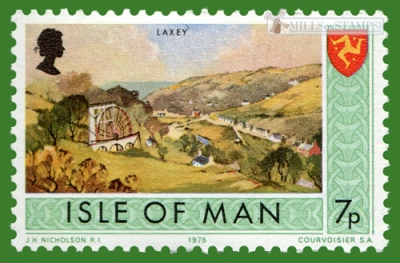-

Number by catalogue: Michel: 59 Yvert: 48 Scott: 54 Gibbons: 24
Perforation type: 11 ¾x11 ¾
Subject:
7 pence. View of Laxey*
Additional:
*Laxey (Manx: Laksaa) is a village on the east coast of the Isle of Man. Its name derives from the Old Norse Laxa meaning 'Salmon River'.
The village lies on the A2, the main Douglas to Ramsey road. Laxey Glen is one of the Manx National Glens, with Dhoon Glen being located close by. The Raad ny Foillan long distance coastal footpath, opened in 1986, runs along the coast through the village.
In the 19th century, mining for lead and zinc began, becoming the largest industry the village has had. The Laxey mines were the deepest in the world in the 19th century. Mining in Laxey came to an end 75 years later in 1929. The village also had a fishing industry.
Laxey village is now a mainly residential and a tourist area boasting several gardens to wander in at leisure, primarily Laxey Glen Gardens. There is also a handweaving mill which sells its own and many other products. The village has five pubs and a Microbrewery, The Old Laxey Brewing Company. The village is built around a glen with a number of steep streets and paths leading to the glen floor, from where it is possible to walk by the side of Laxey River to the outflow to the sea at the small harbour and onto the beach and promenade. It is also possible to walk around the cliffs to the north of the beach, from where there are stunning views of Clay Head to the south.At now the most popular attraction of Laxey is the the largest working waterwheel in the world - Great Laxey Wheel
Definitive issue. Sights and Symbols of Isle of Man
Isle of Man 1975.06.28
In issue: Stamp(s): 2
Issued in: sheets of 50 (5*10) stamps